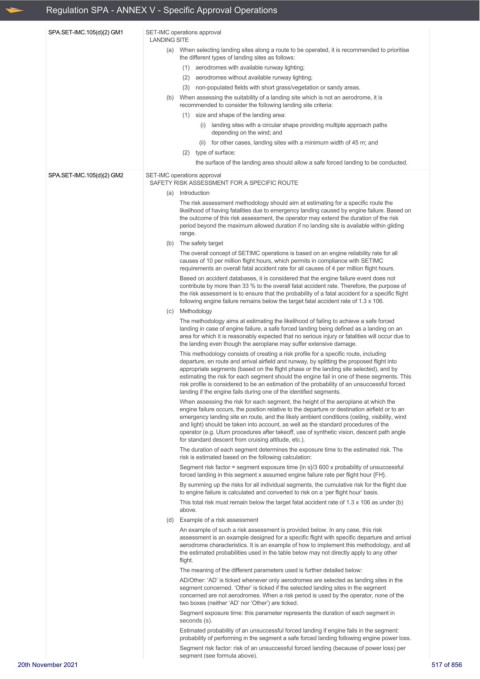Page 517 - UK Air Operations Regulations (Consolidated) 201121
P. 517
~
~ Regulation SPA - ANNEX V - Specific Approval Operations Centrik
SPA.SET-IMC.105(d)(2) GM1 SET-IMC operations approval
LANDING SITE
(a) When selecting landing sites along a route to be operated, it is recommended to prioritise
the different types of landing sites as follows:
(1) aerodromes with available runway lighting;
(2) aerodromes without available runway lighting;
(3) non-populated fields with short grass/vegetation or sandy areas.
(b) When assessing the suitability of a landing site which is not an aerodrome, it is
recommended to consider the following landing site criteria:
(1) size and shape of the landing area:
(i) landing sites with a circular shape providing multiple approach paths
depending on the wind; and
(ii) for other cases, landing sites with a minimum width of 45 m; and
(2) type of surface:
the surface of the landing area should allow a safe forced landing to be conducted.
SPA.SET-IMC.105(d)(2) GM2 SET-IMC operations approval
SAFETY RISK ASSESSMENT FOR A SPECIFIC ROUTE
(a) Introduction
The risk assessment methodology should aim at estimating for a specific route the
likelihood of having fatalities due to emergency landing caused by engine failure. Based on
the outcome of this risk assessment, the operator may extend the duration of the risk
period beyond the maximum allowed duration if no landing site is available within gliding
range.
(b) The safety target
The overall concept of SETIMC operations is based on an engine reliability rate for all
causes of 10 per million flight hours, which permits in compliance with SETIMC
requirements an overall fatal accident rate for all causes of 4 per million flight hours.
Based on accident databases, it is considered that the engine failure event does not
contribute by more than 33 % to the overall fatal accident rate. Therefore, the purpose of
the risk assessment is to ensure that the probability of a fatal accident for a specific flight
following engine failure remains below the target fatal accident rate of 1.3 x 106.
(c) Methodology
The methodology aims at estimating the likelihood of failing to achieve a safe forced
landing in case of engine failure, a safe forced landing being defined as a landing on an
area for which it is reasonably expected that no serious injury or fatalities will occur due to
the landing even though the aeroplane may suffer extensive damage.
This methodology consists of creating a risk profile for a specific route, including
departure, en route and arrival airfield and runway, by splitting the proposed flight into
appropriate segments (based on the flight phase or the landing site selected), and by
estimating the risk for each segment should the engine fail in one of these segments. This
risk profile is considered to be an estimation of the probability of an unsuccessful forced
landing if the engine fails during one of the identified segments.
When assessing the risk for each segment, the height of the aeroplane at which the
engine failure occurs, the position relative to the departure or destination airfield or to an
emergency landing site en route, and the likely ambient conditions (ceiling, visibility, wind
and light) should be taken into account, as well as the standard procedures of the
operator (e.g. Uturn procedures after takeoff, use of synthetic vision, descent path angle
for standard descent from cruising altitude, etc.).
The duration of each segment determines the exposure time to the estimated risk. The
risk is estimated based on the following calculation:
Segment risk factor = segment exposure time {in s}/3 600 x probability of unsuccessful
forced landing in this segment x assumed engine failure rate per flight hour {FH}.
By summing up the risks for all individual segments, the cumulative risk for the flight due
to engine failure is calculated and converted to risk on a ‘per flight hour’ basis.
This total risk must remain below the target fatal accident rate of 1.3 x 106 as under (b)
above.
(d) Example of a risk assessment
An example of such a risk assessment is provided below. In any case, this risk
assessment is an example designed for a specific flight with specific departure and arrival
aerodrome characteristics. It is an example of how to implement this methodology, and all
the estimated probabilities used in the table below may not directly apply to any other
flight.
The meaning of the different parameters used is further detailed below:
AD/Other: ‘AD’ is ticked whenever only aerodromes are selected as landing sites in the
segment concerned. ‘Other’ is ticked if the selected landing sites in the segment
concerned are not aerodromes. When a risk period is used by the operator, none of the
two boxes (neither ‘AD’ nor ‘Other’) are ticked.
Segment exposure time: this parameter represents the duration of each segment in
seconds (s).
Estimated probability of an unsuccessful forced landing if engine fails in the segment:
probability of performing in the segment a safe forced landing following engine power loss.
Segment risk factor: risk of an unsuccessful forced landing (because of power loss) per
segment (see formula above).
20th November 2021 517 of 856

